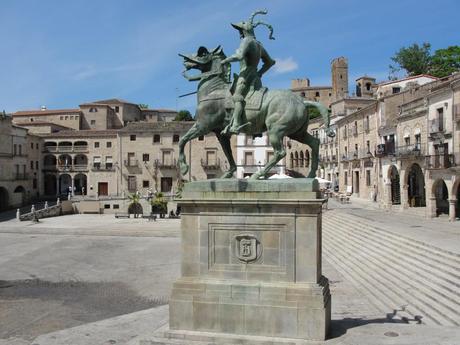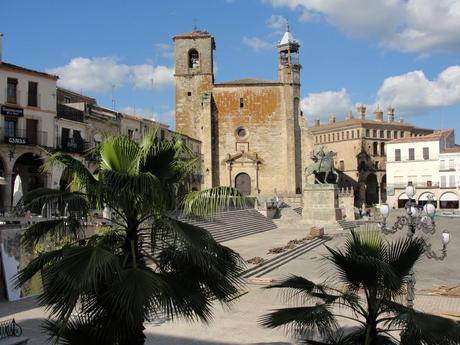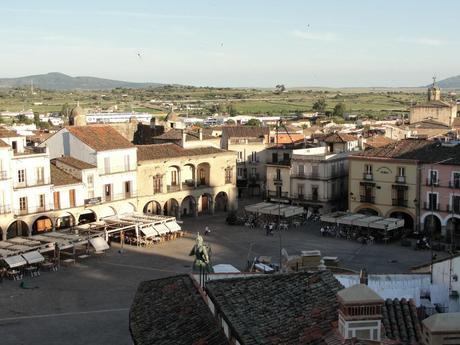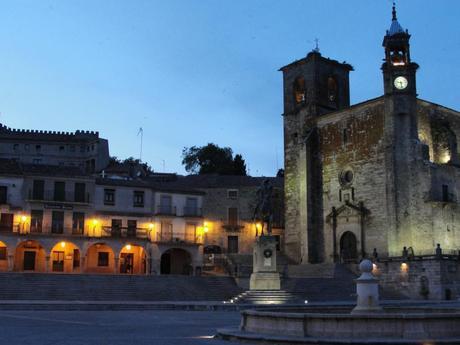 Sometimes your travels take you full circle. This definitely felt the case last month upon setting foot in the ridiculously picturesque Plaza Major in the Spanish hillside town of Trujillo. The town lies in the middle of the thinly populated Spanish region of Extremadura and bar the last remaining daily tour bus which was dragging its way across the medieval stones, some old boys chewing the fat under the arches and some kids using a 500-year old door as a goal frame there was precious little other activity as I stood in the shadow of the imposing equestrian statue of Francisco Pizarro. This, as my guidebook was telling me, is Old Spain, and judging by the lack of crowds it’s also a place that few people can be bothered to trek out to. That’s something of a shame though, as Trujillo is possibly my favorite place in the country – it’s certainly sat at the pinnacle of my Top 5 Iberian destinations beginning with the letter ‘T’.
Sometimes your travels take you full circle. This definitely felt the case last month upon setting foot in the ridiculously picturesque Plaza Major in the Spanish hillside town of Trujillo. The town lies in the middle of the thinly populated Spanish region of Extremadura and bar the last remaining daily tour bus which was dragging its way across the medieval stones, some old boys chewing the fat under the arches and some kids using a 500-year old door as a goal frame there was precious little other activity as I stood in the shadow of the imposing equestrian statue of Francisco Pizarro. This, as my guidebook was telling me, is Old Spain, and judging by the lack of crowds it’s also a place that few people can be bothered to trek out to. That’s something of a shame though, as Trujillo is possibly my favorite place in the country – it’s certainly sat at the pinnacle of my Top 5 Iberian destinations beginning with the letter ‘T’.
To reach Trujillo involved a six-hour car ride from Cadiz – a journey time that would deter many, especially if you have to make it with two young children in tow. Being something of a sucker for a decent Plaza Mayor, however, means I am more than willing to suffer the threat of revolution from a bored audience in the back seats and set sail for plazas new. Any potential mutiny was strangled at birth by regular ice cream stops while for the drivers the end reward was an ice cold cerveza, consumed as the late afternoon sun slowly arched its ways behind the stork-topped, baroque and Renaissance stone buildings that surround Trujillo’s main square.
The drive had been memorable enough in itself, clearing a path over the foothills of the Sierra Morena before entering the parched surroundings of southern Extremadura. There was also an element of eeriness for the number of fellow drivers once clear of Seville could be counted on all the fingers of a 5-a-side football team. It felt remarkably similar to driving across the western states of America, in both geography and scarcity of vehicles. It’s not often in Western Europe that you can find roads so clear, but Spain appears to have more than its fair share away from the major conurbations. This, I’ve slowly discovered, is a country that makes perfect road trip territory.
Extremadura rarely catches the headlines these days; it’s a region out on a limb, nestling up to the Portuguese border to the west, tantalisingly out of reach of the thoroughfares that service Madrid while throwing envious glances below at lively, seductive Andalusia. Judging by some of the locals they probably don’t even give a flying jamon iberico – glad of the anonymity – but there was a time when Extremadura, and tiny Trujillo in particular, were the center of the universe. For it’s here that many of Spain’s legendary conquistadors hail.
Perhaps it was the grinding poverty and hardship of late 15th/early 16th century Extremadura that made some of its inhabitants dream of shores further afield or perhaps there was something in the fountain water that inspired a generation to go rape, pillage and plunder foreign corners of the world not yet known to European eyes, but a freakish number of conquistadors, such as Hernan Cortes (conqueror of the Aztec Empire), Hernando de Soto (conqueror of Florida)and Vasco Nunez de Balboa (discoverer of the Pacific), were all born in the region, while Francisco de Orellana (the first known person to navigate the Amazon River) and the Pizarro brothers (Francisco, Gonzalo, Hernando and Juan) all hail from tiny Trujillo. It’s Franny Pizarro, as conqueror/destroyer of the Incan Empire (all depends on your point of view really – after all, one man’s conquistador is another man’s psychotic greed-fuelled murderer) and founder of Lima who warrants a statue in the main square. The thinking clearly that the more innocent people you annihilate the more prominent your monument should be. In fairness the conquest of the Incan people was a pretty remarkable affair when you consider that Pizarro advanced from Panama into Andean South America accompanied by 180 men and 37 horses and somehow managed to chase an army of 30,000 tooled up Incas out of town. It’s the sort of away day action Millwall could only dream of.

We survived the mean streets of Lima, but I wasn’t so fortunate on the meeker paving slabs of Trujillo. While enjoying that chilled beer I mentioned earlier, contemplating how we’d completed the Pizarro circle by having seen the birthplace and final resting place of Francisco, while also admiring the palaces and churches that had been funded by all that Incan treasure, a smartly-dressed grandmother with Maggie Thatcher hair came over to our table gesticulating frantically in our faces while pointing at our 11-month old son in his pushchair. It’s at moments like these that I wheel out my trusty, well-rehearsed, piece of Spanish vernacular; “Lo siento, no habla espanol.” This has served me well over the years and although often followed by resigned, frustrated gestures by the person I say it to (and possibly also some rude comments once they now know I won’t be able to understand), I’ve found it gains some form of sympathy from whoever it’s spoken to. Not with the Spanish Lady T however – this just made her shout some more. The more I shrugged, the more aggressively she pointed at my son. A Mexican standoff was developing, until she started to repeat mantra-like the word frio. Thanks to the wonders of Dora the Explorer I was finally able to grasp just what she was banging on about. It appeared that she felt my son, who was wearing a short-sleeved baby grow and shorts without socks, was cold. The temperature had been riding in the high 70’s all day and to this Anglo-Saxon it still felt positively tropical. I responded with another one of the words I’d learnt from Dora – caliente. The old lady rolled her eyes, clearly exasperated with this loco inglesa and finally walked off with a despondent shake of the head.
Secretly I knew the cause of her consternation. As much as the Spanish love to see children and take them almost everywhere they go, you only had to look around to see that babies, even on a perfectly warm evening, are dressed up as though the next Ice Age is due to descend within the hour. We’d noted that male babies were quite often kitted out in thick wooly tights, a fashion that delighted my wife who insisted that we buy a pair for our own son. I consider myself a liberal kind of chap, but I came over all 1930’s Yorkshire miner at this suggestion and declared that no son of my mine would be wearing tights. There are some things as a parent that you just don’t want to see. As punishment for such narrow-mindedness, I fully expect to one day be greeted with the news that he has turned his back on the bare-knuckle boxing lessons I’d been forking out for him and wants to take up ballet.
It’s a difficult thing writing about your family, and kids in particular. I’m acutely aware that while to me, my children are the most fascinating thing on the planet – after The Wire, salt water crocodiles and war – they will muster complete indifference to anyone else reading. I’m cool with that, as I almost always find myself drifting off whenever someone else writes about their kids as though we should share the author’s joy at their offspring’s ability to walk/talk/vomit. I’ll try not to over do it, but to ignore my children’s presence would be slightly ludicrous and a little bit impossible – no matter how hard I may try. My wife, Kim, gets to keep her real name as saying something like “her indoors”, “my better half” or “the missus” is a crime worthy of a slow, sinister punishment involving needles and eyeballs. The children shall be called a variety of things depending on how creative/stupid/witty/lazy I’m feeling at the moment they happen to crop up.

The only bit of drama we encountered during dinner were the prices. Trujillo may be in the back of beyond, but they squeeze the tourist dollar for all its worth here. As you would when you are offering tables with such wonderful views. Along the raised section of the Plaza Mayor are a handful of classy restaurants (they have maitre d’s and everything) with outside seating so you can keep a watchful eye over the floodlight Pizarro monument. We took a table at Bizcocho and enjoyed a fantastic meal of stewed bull’s tail and partridge risotto while indulging in the special dessert menu that claimed to be for two persons but really would leave five groaning at the excessiveness of it all.
The wine was something of a revelation too. After being given that uncomfortable task of ordering a bottle from the menu while your waiter hovers over your shoulder, I mumbled something about wanting a local wine while eyeing nervously the prices – there was nothing below 20 Euros besides half bottles. My waiter pointed his pen at a bottle of red called El Silencio, priced at a cool 33 Euros. I gave him a glance over my shoulder and he gave me a look that said, “buy this and you’ll be getting some action tonight.” I returned with a look that said, “I’m staying in the same room as my two children tonight pal, there’ll be none of that malarkey.” Despite ruminating over the fact that for the sort of money they were charging for a single bottle I could have cleared out the entire wine section of the local Lidl with a bumper packet of peanuts thrown in, I relented and went with the recommendation. Without having any concrete method of determining the value of any given meal, this rather expensive one certainly felt like it was worth it if the feelgood factor it instilled in me is anything to go by. Meals like this don’t come around every day after all – unless you live in Trujillo and are minted.
For a town with a population just under the 10,000 mark Trujillo is big on things to see and do. That’s if things you like to see and do involve ancient buildings and artefacts. If they don’t then you’re stuffed – they don’t even get Sky News on the hotel TV to relieve the boredom. It contains a first rate castle, which is surely reason enough in itself to visit because we all love a good castle. Indeed, a recent EU study costing roughly 38 million Euros revealed that European men love a good castle more than a good roll in the hay*. Trujillo’s castillo, with its Moorish origins, is in relatively perky condition considering its age with fully walkable battlements offering a 360-degree viewing platform. From the top there are some stunning vistas across the town below and vast open countryside surrounding the town, confirming its isolated location. It also offers the chance to soil yourself several times over if you bring along a young child who likes to run at high speeds at all available opportunities due to the fact there is next to no safety barriers on stairs or battlements meaning one false step could result in consequences too grim for me to even care to imagine.
After lunch I was left on my own while the rest of the family took some siesta time. Armed with Michael Wood’s excellent Conquistadors I was going to learn a little bit more about the people whose wealth had created so many of the fabulous palaces I was surrounded by while enjoying a few beers. That plan was going great until I was unexpectedly joined by an American couple we had chatted to briefly at the castle. They were from California, just embarking on a month-long European vacation and also traveling with two young children. They weren’t typically American, saying little unless prompted and speaking in almost hushed tones, but as gatecrashers go they seemed pleasant enough. The dad, Ian, had worked in Spain for two years in the early nineties and had always wanted to bring his family back to the country in which he’d spent so much time. Intrigued, I asked him what he had been doing for those two years.
“I was over here on missionary work.”
I weighed this up. Missionary work? Hmmm, this could be a conversation I didn’t want to get into. But if only to fill the ever-widening silences I inquired further.
“So was your work for the Roman Catholic church?”
“Mormon.”
Jesus Christ of the latter day saints that was the one answer I didn’t want to hear. As he said it I put down the beer I’d begun drawing to my lips. Why Mormon? I’d have preferred anything – even jihadists – to Mormon. I’ve nothing against Mormons, they just make lousy drinking partners. With my beer turning warm I told them of the time Kim and I had spent driving across the States and the fabulous week we’d had in Utah. I waxed lyrical about Utah’s beauty with its amazing national parks and stunning solitude, but the mum, Carol, wanted to know what I made of Salt Lake City. I replied carefully with a simple, “it’s an interesting place.” This answer goes way beyond diplomatic as SLC is in fact the most boring city I’ve ever set foot in. And I’ve been to St Albans. The interest lies in the fact that on any street corner within eyesight of the Temple you will encounter young women of varying nationalities asking if you would like a guided tour of Temple Square. Despite insisting that this is not necessary, somehow you will still find yourself being ‘chaperoned’ around and end up watching a 90-minute film about some bloke called Joseph Smith who was visited by an angel called Moroni, found a book made of gold behind some rocks, had another visitor called John the Baptist, started his own religion, got persecuted a lot before being killed which left a power struggle resulting in someone called Brigham Young leading a group of pioneers from Illinois to Salt Lake City to create a permanent home. As stories go it required several leaps of faith to accept everything as gospel and I don’t know what I found more difficult to believe; the bit about angels and John the Baptist or the fact someone named their child Brigham. At the end of this movie ‘epic’ there’s nowhere in town you can buy a drink. Or at least if there is, no one will tell you about it. Like I told Carol (who no doubt had once been one of those women mechanically asking to show folks around), it’s interesting, just not interesting interesting. More interesting in an arched eyebrow kind of way.
Ian was enjoying my road trip story (I think. It’s quite hard to tell when someone just stares at you with only the odd head nod) and gave one of his own, recalling the time he traveled through Death Valley on a Harley. Eager to keep the conversation flowing I jumped straight back in.
“We made the same trip after leaving Las Ve…Las…Erm…Nevada…Yeah. We made that trip.” For some comical reason I couldn’t quite bring myself to say the words “Las Vegas”. I don’t know why. They probably thought I was already sat on a covered wagon on a one-way journey to hell anyway so admitting to a few nights in Vegas was unlikely to worsen things.
“Where were you again?” Asked Ian. “Las Vegas,” I muttered shamefacedly. Suddenly that siesta looked like a good idea.

The meal on the second evening was also spent by the square but without the hefty price tag. My daughter, still outrageously active at 10pm despite giving me the runaround on the castle walls earlier, was happily entertaining herself beneath the arches with a balloon donated to her by a waiter. Up and down she ran under my careful gaze, getting pats on the head from passing strangers and waiters alike, allowing me to ponder the greatness of the Med countries that are so welcoming to children and don’t even quiver an eyelid at the sight of your kids tearing around like loonies at a time that the UK has seemingly made constitutionally illegal for children to show their faces at.
I had that warm feeling inside gleamed from a mixture of alcohol and smugness at discovering a new ‘favourite’ destination – plus relief at not having wasted a day of your life in a car only to turn up at somewhere with as much charm as Stoke-on-Trent – when my eyes made contact with a familiar glare. La Granimator was back. And this time she was threatening to confiscate balloons. I trudged wearily over to her as she stood over my perplexed daughter issuing some directives about the perils of a road that was a good 20 metres away. Plus no doubt something about the unsuitability of her evening wear. She gave me the lecture too – in Spanish – as I stood there with a forced grin that gradually began to make my face ache such was the length of the sermon, engaging in a mild game of tug of war with the balloon – I say mild, it was more just a case that Spain’s version of Mrs. Mangle wasn’t letting go and I was quite keen not to appear to be wrestling her for it, despite the lingering temptation. When she had finally stopped and released the balloon I thanked her – in Spanish – for what was probably one long bollocking regarding the inadequacies of my parenting abilities.
I was beginning to understand why Francis and his brothers upped sticks; if they had to put up with busybodies like this all through their youth, you’d probably be tempted to sail half way around the world to take your rage out on a vertically challenged, cocoa-leaf addicted group of people who you had never clapped eyes on before. Especially if they happened to own lots of gold. Senora Frio wasn’t running us out of town though. We were on our way anyway. But we’ll be back. Of that there’s no doubt. This place has conquered my heart.

* sources unconfirmed at time of going to press
